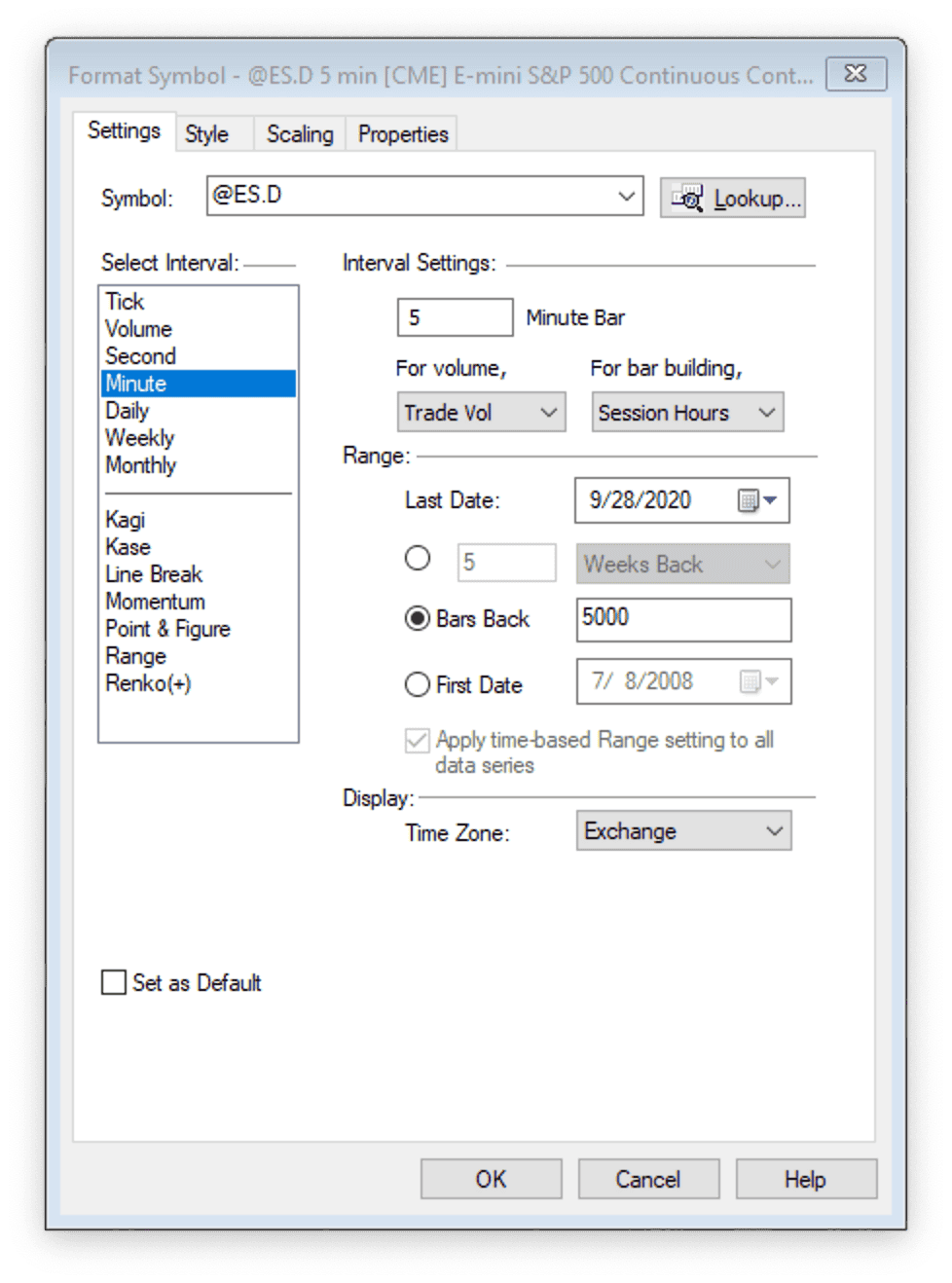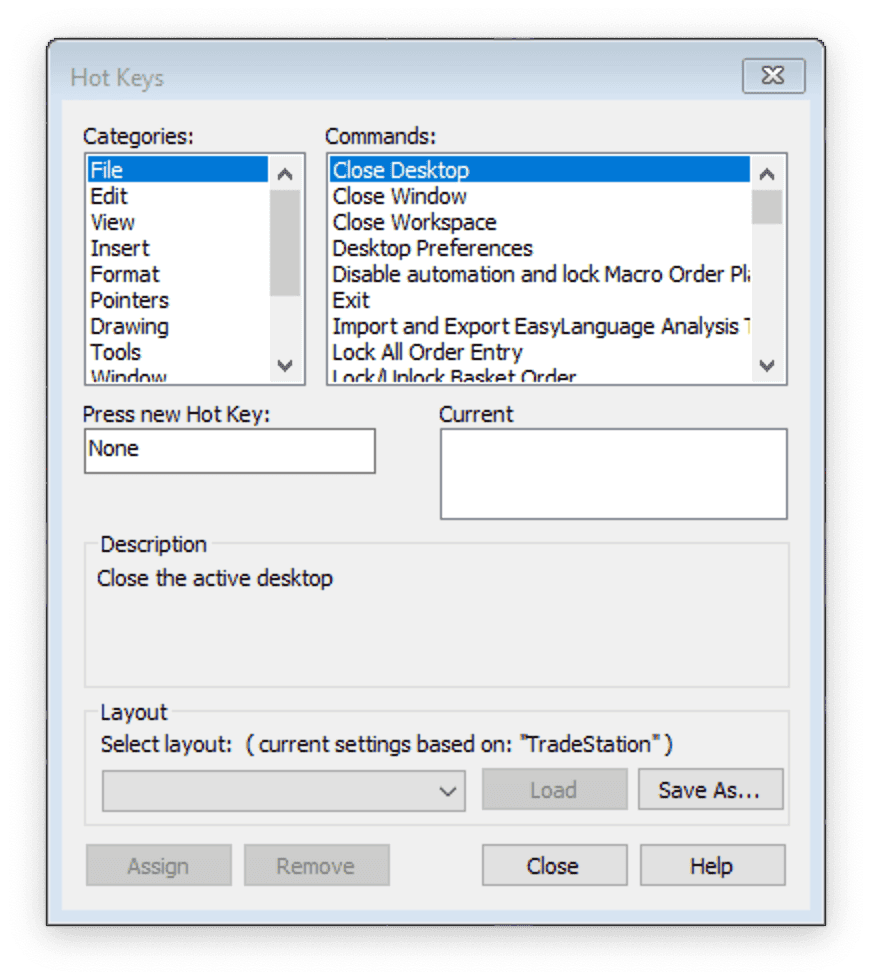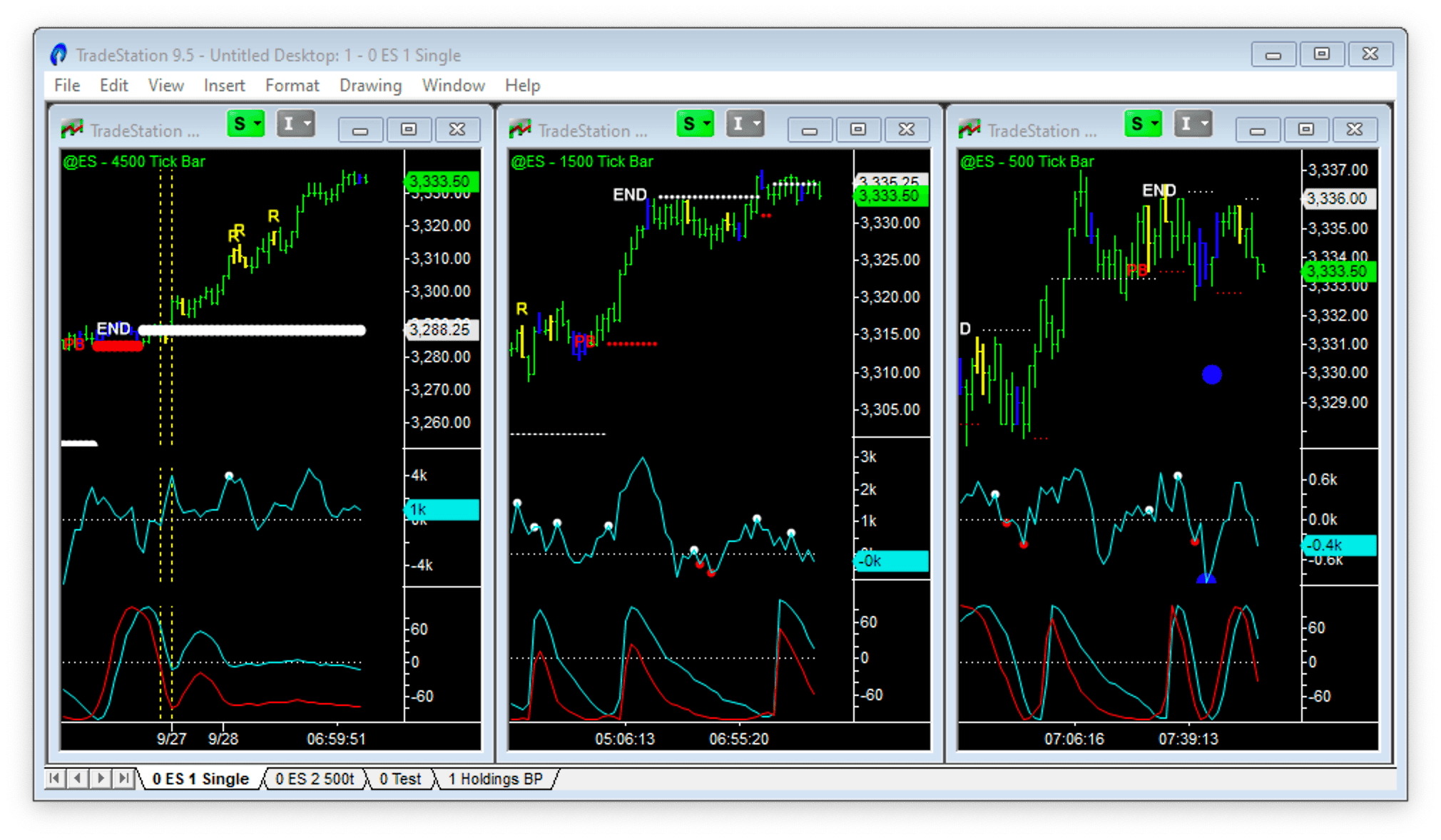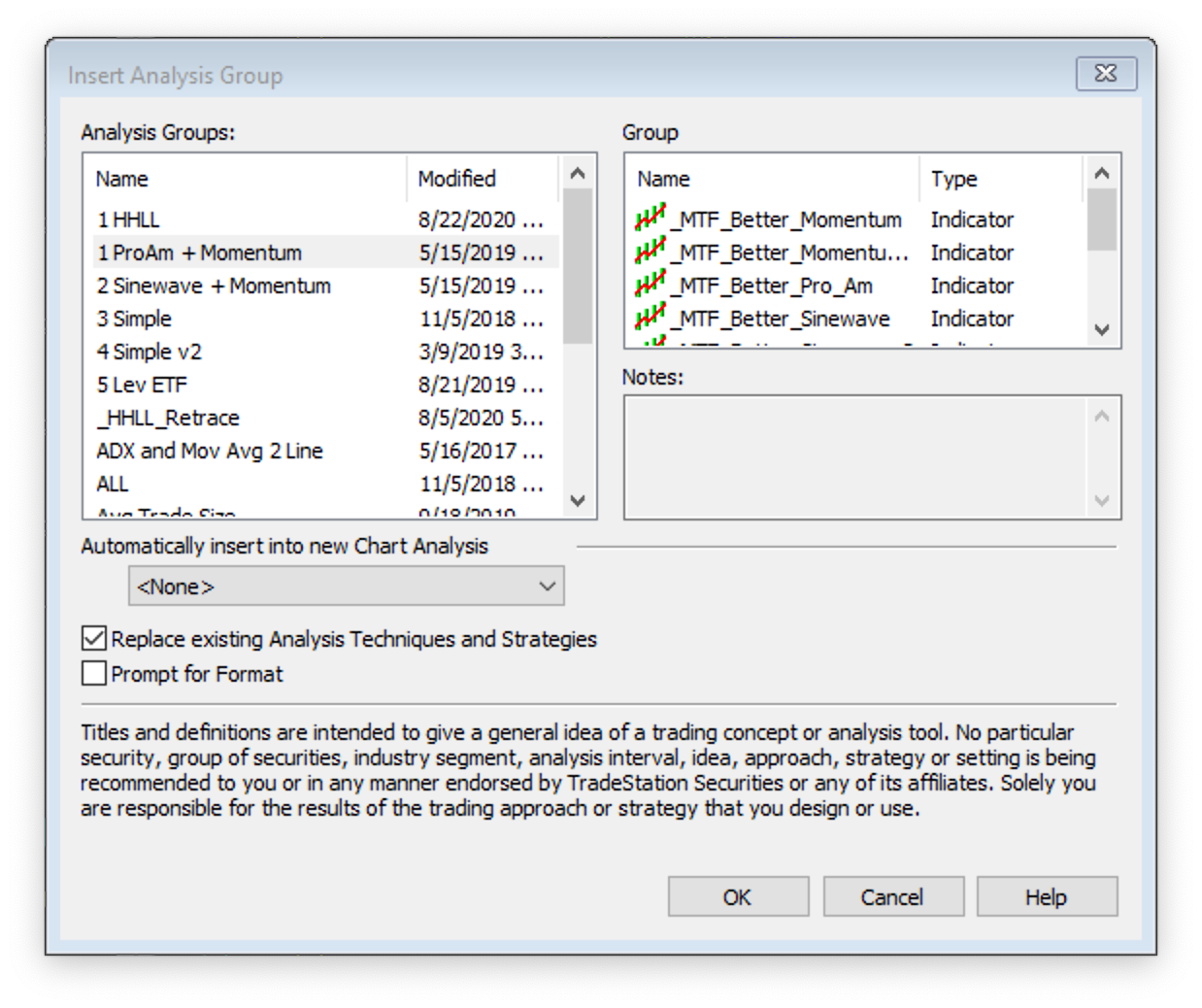How Do I Add Drawing Tools to Desktop in Tradestation
A good carpenter knows his tools – and if you're a trader, your charting software is your just about important instrument. Thusly vex know it, at bottom and out.
I've been using TradeStation for intimately 20 years! And before that I used SuperCharts, which was the forerunner to the TradeStation charting platform. Based connected that experience, here are my top suggestions and answers to whatsoever of the nearly frequently asked questions about using TradeStation. Use the links below to jump to a particular subject:
- How to support your TradeStation charts and EasyLanguage files
- Why use "continuous" futures contracts
- Why use 1440 minute intra-Clarence Day charts instead of daily charts
- What 'Format Symbol' settings should I use
- How to setup Hot Keys for frequently misused functions
- How to setup Scorching Keys for workspace and windowpane pointers
- How to frame-up Hot Keys to move between charts
- Why link chart windows with the indistinguishable symbol
- Why function Analytic thinking Groups in TradeStation
- Why you postulate to rationalize and standardize your charts regularly
- How to change indicator settings quickly crosswise multiple charts
- How to change the text size in TradeStation
- Why you need the quickest Internet connection realistic
- How to access TradeStation through a Firewall
- Wherefore you might need to re-load your cached data
- How to tell if your Internet connection is "glitchy"
- Wherefore you should register the TradeStation manual
- How to get more answers to TradeStation questions
- How to learn TradeStation EasyLanguage
How to computer backup your TradeStation charts and EasyLanguage files
You've heard this before from me – backup, backup, backup. Call up IT can buoy't happen to you? Your hard drive fails or you get burgled. Save yourself the stress and be after for tragedy.
TradeStation has a backup capableness in-built. Set this leading to run automatically, every hebdomad, at 3am so it doesn't get in your way. To boot, every month I exportation and save all my EasyLanguage files victimisation the export wizard. These are saved happening my hard drive and then I use Google Drive to automatically relief all my hard driving files off-site, in the taint.
There's a full explanation in this article: Trading Substitute Contrive – My 7 Ill-use Contrive for Hardware Failure
Why use "sustained" futures contracts
I see so numerous charts from traders where they've plotted the current futures contract (e.g. ESZ19). That's great but they have to change it at rollover. If you use the "continuous" contract version (e.g. @E) as an alternative, the rollover happens automatically – plus all the history is already on the graph.
Wherefore use 1440 minute intra-Clarence Shepard Day Jr. charts alternatively of daily charts
Particularly useful for acquiring volume information quicker. End of Clarence Day intensity data is delayed – the exchanges don't loss it until well afterwards the close. But if you use a 1440 min intra-twenty-four hour period chart (1440 minutes = 24 hours) so you'll get the running sum book listed and have sex what the daily volume was before it's free by the exchange. Sometimes the exchange makes some adjustments to the figure simply it's usually pretty close.
In addition, on a 1440 microscopic chart TradeStation splits the day's volume into "Up Volume" and "Down Book". "Up Mass" is volume listed at the Enquire price and can therefore be considered aggressive purchasing. "Depressed Volume" is volume traded at the Bid price and can similarly be considered to be aggressive selling.
By keeping track of this "real" buying and selling mass you can keep track of the strength of a trend. Breakouts into drift typically start with a large volume of aggressive volume. And trends peter out when the buying volume backs off, even as high prices are printed.
Indeed this "real" buying and selling volume data is really multipurpose.
What 'Format Symbol' settings should I use

The TradeStation 'Formatting Symbol' settings chit causes some people a couple of problems. This is easily unchangeable.
Make a point your settings are "For bar construction, employment: > Academic term Hours" instead of "Natural Hours". In that way, TradeStation knows the jump building bars at the commencement of the trading session, or else of using whole hours.
Then make dependable your settings are "Time Geographical zone: > Change". So that timestamps on your charts reference the exchange clock time, rather than your computer time. This is antitrust a convention that traders manipulation, so there's atomic number 102 confusion when comparing charts from traders in different locations and fourth dimension zones.
Lastly, I use 5,000 bars back for history on the chart. This gives my indicators plenty of time to reach "steady state" when calculating and updating.
How to setup Hot Keys for frequently used functions

Hot Cay settings can be found under View > Sexy Keys. I have Hot Keys for new workspace, new window, copy/paste window, workspace pointer, window pointer, change workspace, deepen window, etc.
You can move around TradeStation such more quickly by using the built-in or your own custom Hot Keys.
How to setup Hot Keys for workspace and window pointers
If you purpose multiple time frame charts you'll often want to see where you are. Instal a Hot Key to add a pointer that shows where you are on all the charts open in a workspace. I use "]" for showing the arrow in all windows (surgery charts) in a workspace. And I habit "\" for showing the pointer in just one window (OR chart).
Useful for reviewing history and visual perception what was happening in each of the different time frames. I use this at the end of all day to review the day's Emini trading and setups.
How to frame-up Illegal Keys to act up betwixt charts
Tardily one hither and already setup with the default TradeStation settings. You can select the workspace you want to view with mastery + page up/down. Then select the window (or chart) you privation to glucinium live with control + tab. Finally, change the bar spacing with the up and down arrows.
Why link chart windows with the same symbol

The symbol windowpane radio link ("S" in the top right of each window) bequeath join together different time systema skeletale charts of the same symbolisation. If you shift the symbolisation in one chart – all the other charts will change too. Really handy if you lack to look at a sequence of symbols in assorted time frames. For example, daily, weekly and time unit charts for swing trading stocks. Or in the case above, 3 tick charts – 500, 1,500 and 4,500 ticktock.
Besides as linking symbols, you can also link timeframes. Use the interval window link ("I" in the top right of each window) to join together different symbol charts of the same timeframe. For instance, you could have all the major indices (S&P500, Dow, NASDAQ and Russell) jell up in charts and then toggle switch betwixt daily views, weekly views and monthly views.
Why use Depth psychology Groups in TradeStation

Compound your favorite indicators and their settings into an Analysis Group so you can MBD them to a chart all in one "hit". You can also add this indicator group automatically to whatever modern chart you start.
Suited fall into place happening a chart takes you to a number of options – including the Analysis Group settings.
Wherefore you motivation to cut out and standardise your charts regularly
How to Organize Your Charts in TradeStation
We entirely sleep with – try out distinct indicators, smel at different markets, ADHD complexness to our analysis. Only "analysis paralysis" lavatory be toxic – day trading conclusion making inevitably to be fast and having conflicting indicators or markets will just tie you up in knots.
My suggestion is to regularly see your charts and delete the ones that are not essential – do you real need that chart of the Japanese Yen versus Krona?
Then make up a standard indicator Analysis Group that you purpose for all charts and all time frames. It should have the minimum number of indicators with completely the settings just as you like them. Then apply it to all your charts – you'll get over quicker at reading your charts and you'll insure tradable patterns repeating. For Maine, the ultimate is just having indefinite chart with all 3 of the Better indicators and trade entries and exits signaled – and nonentity other. One day…
How to switch indicator settings quickly across quadruplex charts
Difficult to explain this one, but I'll try. This is a very useful mode of making orbicular updates to things like indicant colors, lookback periods, etc.
EasyLanguage indicator encode: 200 Day Pipeline
Variables: Length(200), HighColor(Red), LowColor(White);
Value1 = Highest(H,Length);
Value2 = Last-place(L,Length);
Plot1(Value1,"High",HighColor);
Plot2(Value2,"Low",LowColor);
Rather than go into all chart you've added an indicant to and changing the colours, etc. – you can set the same just by changing the EasyLanguage code once and re-verifying the indicator code. Just make sure the things you mightiness want to change are coded American Samoa "Variables" and not "Inputs". See the example code above.
How to convert the school tex size up in TradeStation
I often get asked this query: "How coiffure you change the default text size in TradeStation?" Well, here are the steps:
- Quality Drawing > Text
- Write some textbook on your chart
- Right chatter the text and Format the font, size and semblance
- Tick the "Set as default" boxwood > Okay
- Opportune snap and Remove the text
- Ctrl + R will update the chart with the new text formatting
Plus any new chart will have the new text formatting.
Why you need the fastest Internet connection imaginable
Your biggest bottleneck is not your computer processor speed, RAM, hard disc drive, operational system, etc. – it's your Internet connection speeding. Let ME try and explain. Indicators are very simple – fitting a calculation loop topology that is repeated at the contiguous of a taproo normally. And computers are very good at doing repetitive calculations very fast.
Take the model of a dated computer running something like an Intel Core group i3 at 3GHz. This processor will execute 50,000+ MIPS or one thousand thousand operating instructions per second. That's 50 billion instructions per second. Now IT takes a a few instructions for the processor to execute a full calculation, so 50 billion instruction manual is roughly 5 billion CALCULATIONS per second.
Now let's liken that to your typical home Net connection upper. Let's assume you have "basic" cable and you'Ra getting a download speed of 4 Mbps – that's 4 million bits per second or 0.5 million bytes per second. So your processor is open of running 5 billion calculations per second but your Internet connection is only when delivering 0.5 million bytes of information per second.
Your computer processor is capable of continual 10,000 times faster than your Internet connective!
Now I'm not a reckoner organise and some of my assumptions might be out – but I'm sure you make the picture. E'er wondered why Goldman Sachs wants to co-locate information technology's computers next to the exchange's computers? Now you know. The years of upgrading your RAM, computer processor and nontextual matter card are over – they're moving at warping speed compared to your basic Internet.
And when you're evaluate the hasten of your Internet connection, assume't forget to measure to the server delivering the information – non your topical anesthetic server. In my case this is the difference between measure the speed to a Sydney suburb in Australia versus Texas (where the TradeStation information servers are placed). Measure network rotational latency too as throughput. They both impact reaction time. A few years ago:
- My local Sydney server gave results of 60+ MBps throughput and 10 ms latency.
- The Texas servers gave results of 2-4 MBps throughput and 250 Magnolia State latency!
How to access TradeStation through a Firewall
If you're behind a Firewall, when you try and backlog into TradeStation you'll be told you are not connected to the Internet. Then TradeStation will just cycle through continually stressful to get a connection but go bad. You can use the Terminal lotion to check aside typing "telnet 63.99.207.100". This is asking to make a telnet connection to unrivaled of the TradeStation information server IP addresses. If "Unable to connect to outside horde" comes backwards then you're definitely behind a firewall.
To bypass the firewall here are the specified instructions you need the network administrator to action. It looks complicated but to a network guy it should be straightforward.
Alternatively use a VPS, which stands for Virtual Private Server. Effectively this is a virtual computer, machine-accessible directly to the Internet grit and hosted by an ISP. You access this realistic computer through any computer with an Cyberspace connection (what we used to call a "dumb" terminal) using Microsoft Far Desktop Connection (or other Mac OS X app).
The beauty of this approach is that your practical computer has a very fast connection to the Net and trading data – plus it can be very extremely specification'd and just running your trading platform. Hence getting maximum performance. Then your terminal computer righteous needs a nominal Cyberspace link to "see" and control the virtual machine.
Why you might need to re-loading your cached data
This is one of most useful fixes I make out of – particularly for heavy users of Ticktock charts, like me.
If you find your tick charts slow to load, past your cached data English hawthorn follow corrupted. Alternatively, if you have a poverty-stricken Internet connective with "micro-outages" your tick charts may show gaps. Both of these problems bathroom be fixed by re-building your cache. Here are the stairs in TradeStation:
- Shut down TradeStation
- Find the cache pamphlet –
In TradeStation 9.5 it is here: C:\Program Files (x86)\TradeStation 9.5\Program\Cache
In TradeStation 10 it is here: C:\Users\[UserName]\Documents\TradeStation 10.0\CAL\Cache - Re-name the hive up folder to something the likes of Cache_Old
- Ray-pop out TradeStation and open some of your charts
This will force TradeStation to access the historic information on their servers and atomic number 75-build your data stash. Try to do this out of hours, not during the trading day, as the data downloading will be dilatory. Try on IT – IT whole kit and boodle like a care for all time.
How to tell if your Internet association is "glitchy"
How to Check Your Data Connection in TradeStation
Again, if you're a heavy user of Tick charts like ME, you need to be intimate that you're receiving every "tick" of data in the information feed. If your Internet connection and/or WiFi signal is "glitchy" you'll experience "micro-outages" and data packets volition be lost, technically called "Jitter". There are various online tools for measure packet exit and Jitter, including this one.
Simply TradeStation too has a very expedient built-in function that can help measure "little-outages" and tell if you have a problem. A graph of the symbol '== BYT' shows TradeStation bandwidth usage (in Kbits/second) every second base.
Keep this chart running during the trading day session (with your usual tick bar charts for trading also open) and if the indicator line plotted ever hits zero, you'll know that you clean missed some data. The odd zero diagram shouldn't be a bear on, simply if you are showing six-fold, consecutive zero plots then your Internet and WiFi connectedness are poor – and you'll need a fix!
You can also be alerted whenever you have data glitches by adding the 'Information Flow Lost' index number by JRG (just search the TradeStation forums for the code) to a 1-tick '== BYT' chart described in a higher place. Here's a snippet of the index code:
Wherefore you should read the TradeStation manual
IT's terribly unfashionable to read manuals these days – it should all just work and be totally intuitive, right? Wrong. Charting computer software is some of the most complex outgoing there and literally takes years to master, specially if you indite your own encipher.
But getting answers is a lot quicker these days. Manuals usually come in PDF or online format and are searchable. Forums are an amazing resource – and one of the keys in deciding which charting software package to use – make a point you've bookmarked yours. If you're having a problem or curious about how something works in TradeStation, I guarantee on that point's a meeting place thread or article written about IT.
Existent-time if you observe your information not updating or unmatched of your charts doesn't look right – check the forums (or Twitter) first. The exchange mightiness have finished something, strange traders might have known the problem too – you're not alone out there.
(Note: TradeStation Mesh Status has ne'er worked for me in showing problems literal-meter. It invariably shows all ill lights and everything is running fine. Not.)
How to get down more answers to TradeStation questions
Dismiss't find it in the manual? Assume't register manuals! Past usance Google rather.
Type this into the Google search box seat
site:https://tradestation.com "search term"
This will restrict the Google results to just the TradeStation site, including the very useful TradeStation forum. Alternatively search for "search term" summation TradeStation operating theatre EasyLanguage.
How to learn TradeStation EasyLanguage
How to Learn TradeStation EasyLanguage
All traders need (at to the lowest degree) alkaline coding skills. TradeStation EasyLanguage is important – simple enough to pick up quickly and compound sufficiency to do some pretty nifty analysis. Sure, sure, you C++ and C# coders can do anything – but for ME it's too tall. Plus I'm an old dog and stuck in my ways.
Present are some TradeStation EasyLanguage resources to get started:
- TradeStation EasyLanguage PDFs
- TradeStation EasyLanguage video tutorials
- Martyn Whittaker video tutorials and guides
- TradeStation Forum (you pauperization to be logged in for access)
- Search role in TradeStation Forum
- Listing of EasyLanguage specialists
If you've never coded – give it a go. You might be sunnily surprised how easy TradeStation EasyLanguage is.
So there you go, I hope you found these sentence saving TradeStation tips and tricks helpful.
How Do I Add Drawing Tools to Desktop in Tradestation
Source: https://emini-watch.com/emini-trading/tradestation-tips/
0 Response to "How Do I Add Drawing Tools to Desktop in Tradestation"
Post a Comment